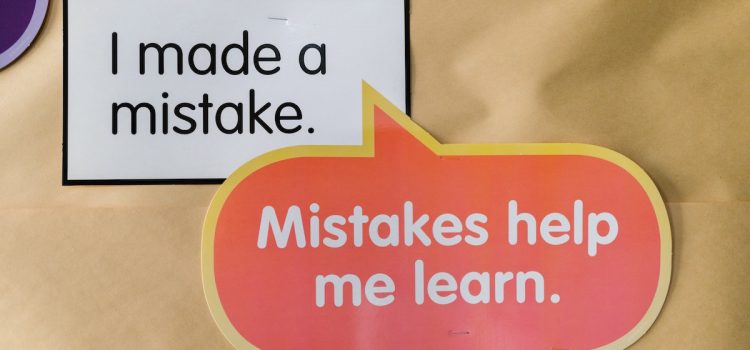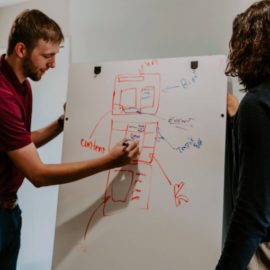

This article is an excerpt from the Shortform book guide to "Where Good Ideas Come From" by Steven Johnson. Shortform has the world's best summaries and analyses of books you should be reading.
Like this article? Sign up for a free trial here.
What famous inventions resulted from mistakes? How do errors impact your thinking?
Best-selling author and theorist Steven Johnson explores where good ideas come from. One source might surprise you: errors. Johnson explains that, when we learn from our mistakes, we often find ourselves in exciting new territory.
Continue reading to learn how mistakes can lead to new ideas.
What We Learn From Our Mistakes
Johnson argues that mistakes can lead to better ideas and greater innovations. Many inventions throughout history have been the result of mistakes, including penicillin, the daguerreotype, and the pacemaker. He suggests that making mistakes and then exploring why those mistakes happened makes people smarter. When we learn from our mistakes, we open up to new ways of thinking and explore additional ideas in the adjacent possible.
(Shortform note: Research suggests that you learn more from mistakes if you believe you can learn from your mistakes, as opposed to believing that your intelligence is fixed and that mistakes are personal failings. This suggests that learning from mistakes has more to do with your mindset and openness to exploring what went wrong than the simple act of making the mistake itself.)
Johnson also describes a study carried out by Berkeley professor Charlan Nemeth that showed that mistakes in group settings (or networks) cause people to think more flexibly. In the study, a group of participants was shown a series of colors on different slides and asked to list some words they associate with those colors. The vast majority of the associations were predictable, like associating green with “grass.” However, in subsequent studies, actors were added to the group who deliberately identified the colors incorrectly, like saying they saw a blue slide as green. The actual participants then began making much more creative associations, suggesting that adding inaccurate information to the group’s pool of knowledge led to greater creativity. Further studies showed similar results in settings like mock juries.
(Shortform note: While these studies may suggest that it’s beneficial to have someone deliberately play “devil’s advocate” in groups that are coming up with ideas or making decisions, Nemeth has added in her other work that the devil’s advocate—someone who agrees with the majority position but is deliberately drawing attention to alternative arguments—is not as effective at prompting different types of thinking as someone who genuinely believes in the minority position. In fact, Nemeth’s research suggests that the devil’s advocate position can actually reinforce the majority position rather than eliciting dissent.)
Johnson notes that even evolution makes use of errors to improve a species. Mutations, which are essentially errors in DNA, create changes in an organism, and if those changes are beneficial to its survival, they’re passed down to its offspring. The majority of mutations are either neutral or harmful, but some push a species into a new realm of the adjacent possible, which is how we went from single-cell organisms billions of years ago to the vast array of diverse species we have today.
(Shortform note: Mutations, like human discoveries, also seem to develop by means of “the multiple,” as research shows that different mutations can lead to the development of the same beneficial trait. In other words, the same features in the adjacent possible can be achieved from different combinations of mutations. Scientists think these “multiple” mutations may be more likely to persist through generations because traits that result from a specific, complex mutation are less likely to occur in different organisms—and thus less likely to be passed down to more offspring—than traits that can result from different combinations of mutations.)
Johnson suggests that organizations that seek to eliminate error are closing themselves off to greater ideas in the adjacent possible. He says that, while the goal shouldn’t be to make mistakes, they should be embraced and allowed to happen. Only then can we truly understand and learn from them.
(Shortform note: In The Five Elements of Effective Thinking, Burger and Starbird go a step further and recommend making mistakes on purpose in order to prompt deeper thinking and exploration of an idea. They note that beating yourself up over a mistake or discouraging yourself or others from making mistakes is unproductive and that you should in fact reward people for mistakes because it shows learning and creativity. They recommend making leaps in logic you know are incorrect and following that idea through to its conclusion to see what other ideas it opens up.)

———End of Preview———
Like what you just read? Read the rest of the world's best book summary and analysis of Steven Johnson's "Where Good Ideas Come From" at Shortform.
Here's what you'll find in our full Where Good Ideas Come From summary:
- How the world's best inventions grow from minor inklings
- How capitalism negatively impacts innovation
- Why making mistakes is essential to great innovations






